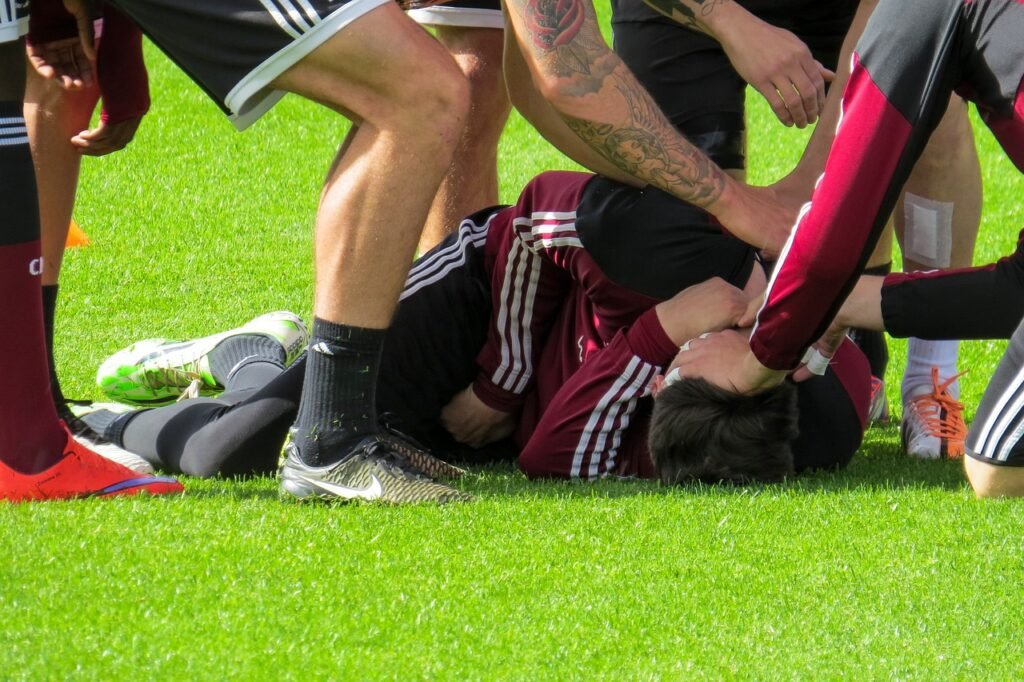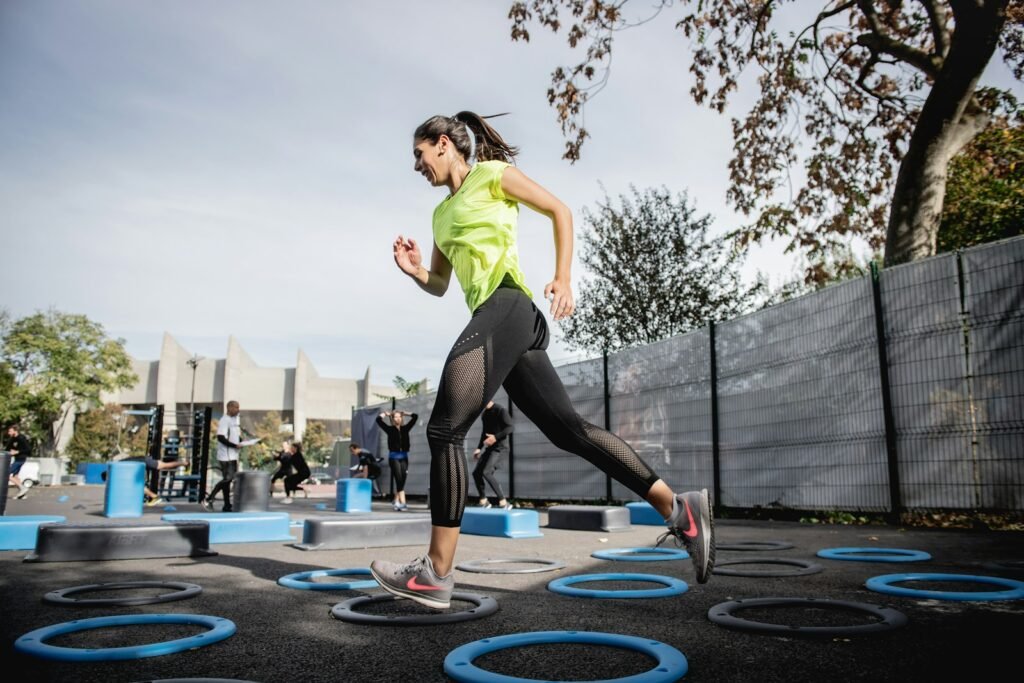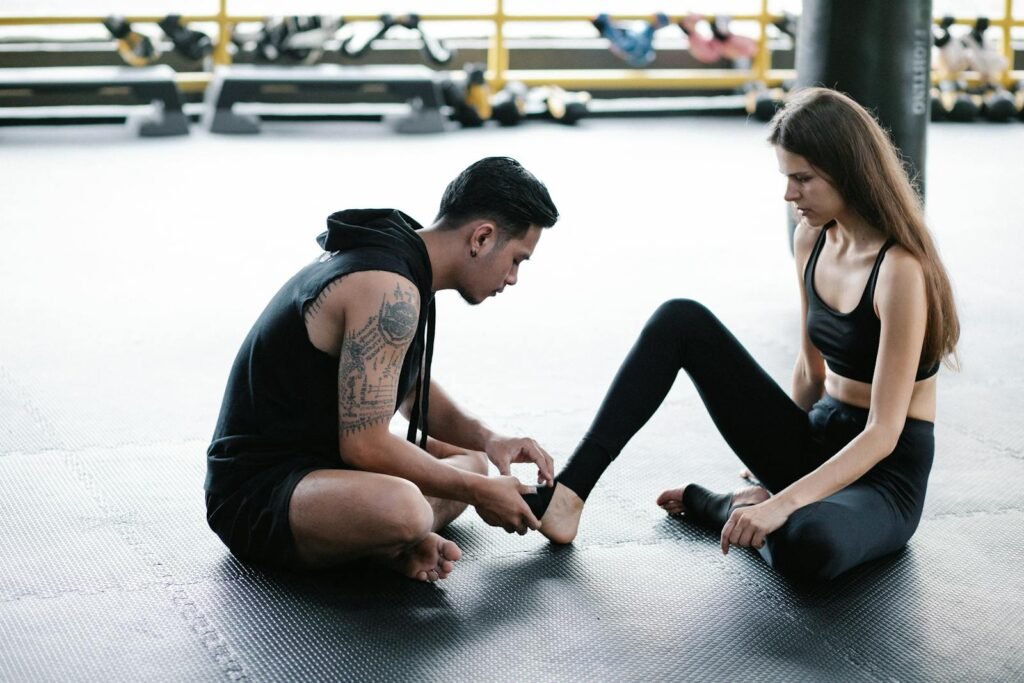As a runner, I’ve felt the excitement of pushing my limits. But I’ve also faced the disappointment of injuries. Whether you’re an experienced athlete or new to fitness, avoiding injuries is key. A small injury can stop your progress fast.
In this guide, I’ll share smart ways to stay injury-free. You’ll learn about warm-ups, choosing the right gear, and recovery. By using these methods, you can improve your performance and keep your body healthy.
Key Takeaways
- Proper warm-up routines can increase muscle flexibility and blood flow, reducing the risk of injuries.
- Gradually increasing workout intensity and duration helps prevent overexertion and subsequent injuries.
- High-quality sports gear, such as well-fitted shoes and protective equipment, significantly contributes to injury prevention.
- Strength and conditioning exercises strengthen relevant muscles and improve overall fitness, lowering injury risks.
- Adequate rest, hydration, and proper nutrition are key to preventing fatigue-related injuries.
Understanding Sports Injury Risks and Common Types
Sports and fitness activities are exciting, but they also carry injury risks. As athletes or fitness lovers, knowing common injuries, risk factors, and seasonal impacts is key. This knowledge helps in recovery and sports medicine.
Most Frequent Training-Related Injuries
Common injuries include stress fractures, runner’s knee, tennis elbow, and rotator cuff injuries. These happen from overtraining, bad technique, and poor gear. For instance, too much contact in sports can cause concussions, leading to brain and body problems.
Risk Factors in Athletic Training
Many things can raise injury risks, like being young, old, or overweight. Kids are more at risk because they’re always active and push limits. Older people and the overweight face more risks due to joint stress.
Impact of Seasonal Changes on Injury Rates
Season changes affect injury rates too. Starting to be more active in warmer months can increase risks. Past injuries also predict future ones, showing the need for good athletic injury rehabilitation plans.
Knowing common injuries, risks, and seasonal effects is vital for sports medicine strategies and injury risk assessment. Awareness helps athletes prevent injuries and stay healthy and perform well.
Essential Pre-Workout Warm-Up Strategies
Doing a good pre-workout warm-up is key to avoiding injuries and performing well. It boosts blood flow, warms up your body, and gets your muscles ready for what’s ahead.
Begin with light cardio like jogging or jumping jacks to raise your heart rate. Next, do dynamic stretches that match your workout’s movements. These stretches boost flexibility and reduce injury risks.
A good warm-up should last 10-15 minutes. It lets your body warm up, heart rate increase, and muscles get ready for exercise. Don’t do static stretches for too long, as they can weaken your muscles.
Make sure your warm-up targets the muscles you’ll use in your workout. Runners might do leg swings and hip rotations. Weightlifters might do light versions of their main lifts. This customizes your warm-up and helps prevent injuries.
“An effective warm-up should last around 10 to 15 minutes to allow the body temperature to rise, the heart rate to increase, and muscles to become more flexible and prepared for exercise.”
Finish with 15-20 seconds of static stretching for each area to loosen any tightness. This extra stretching can improve flexibility and lower injury risks.
Putting effort into a good warm-up is a simple yet powerful way to avoid injuries and do better in your workouts. Just a few minutes of preparation can make a big difference in your performance.
The Role of Proper Equipment and Gear Selection
Choosing the right protective sports equipment is key to avoiding injuries. High-quality padding, helmets, and shoes have made sports safer. Yet, young athletes face higher injury risks due to intense training.
Using the wrong gear or poor training practices can lead to more injuries. It’s important to pick the right gear for your sport and level of training.
Choosing the Right Footwear
Good footwear is vital for stability and comfort during tough workouts. Wearing the wrong shoes can cause foot problems and increase injury risk. Always choose shoes that fit well for your sport and training level.
Protective Equipment Guidelines
Wearing the right protective gear is essential. It should fit well and match your sport. Research shows that bad fits can lead to more injuries. Using gear that meets standards can greatly reduce injury rates.
Gear Maintenance and Replacement
Keeping your sports equipment in good shape is vital. Old or neglected gear can cause serious injuries. As you grow and train more, your gear needs may change. Replacing it regularly is important for safety and performance.
| Equipment Type | Proper Fit Guidelines | Maintenance Tips |
|---|---|---|
| Footwear | Snug in the heel, with enough room for toes to move freely | Replace shoes every 300-500 miles or when worn out |
| Protective Gear | Tight enough to stay in place, but not restricting movement | Inspect regularly for cracks, tears, or signs of wear and tear |
| Recovery Equipment | Comfortable and supportive, tailored to individual needs | Clean and store properly between uses to extend lifespan |
Using the right protective sports equipment and following proper equipment usage is vital. It helps prevent injuries during training. By choosing the right gear and keeping it in good condition, you can improve your training and stay safe.
How to Prevent Sports Injuries Through Proper Form
Keeping the right form and technique is key for injury prevention techniques and sports safety measures. Beginners should get help from pros to learn how to move right. Even seasoned athletes can learn new things and keep their posture correct with coaching.
Good form cuts down on overuse injuries, which are common in sports. These injuries, like tendinitis and muscle strains, can keep athletes out for a long time if not prevented.
Learning the basics of your sport well can save your body from harm and injury.
Key Steps for Maintaining Proper Form
- Get help from a certified coach or sports medicine expert to learn the right ways to do your sport.
- Do drills and exercises that focus on the right form. Start simple and get harder as you get better.
- Check and improve your technique often. Make changes to keep your body in the best position.
- Listen to your body. Pain or discomfort means you might be doing something wrong or too much.
- Add injury prevention exercises, like core strengthening and balance training, to help keep your form right and lower injury risk.
By focusing on proper form, you can lower your chance of sports injuries and have a long, healthy sports career.
Strength and Conditioning Fundamentals
Adding strength and conditioning programs to your training is key to avoiding sports injuries. These programs build muscle strength, endurance, and physical fitness. This can greatly lower your chance of getting hurt during training.
Core Stability Training
A strong core is vital for good posture and body alignment during sports. Exercises like planks, bridges, and abdominal workouts help prevent back injuries. They also boost your athletic performance.
Balance and Coordination Exercises
Balance and coordination exercises are critical for injury prevention. They help your body stay stable and in control. This reduces the risk of falls and sprains that can lead to injuries.
Activities like single-leg balancing, agility drills, and plyometric training improve balance and coordination.
Progressive Resistance Training
Increasing the intensity and resistance of your workouts builds muscle strength and endurance. This is key for joint stability and athletic performance. A gradual increase in resistance helps your body adapt to your sport’s demands.
A well-designed strength and conditioning program tailored to your sport and fitness level is powerful for injury prevention. By focusing on these key training principles, you can improve your athletic skills while lowering injury risk.
Smart Training Progression and Load Management
Injury prevention in sports needs a smart plan for training and managing loads. It’s important to slowly increase how hard and long you train. This lets your body get used to it safely and lowers the chance of getting hurt.
The 10% rule is a good guide. It says you shouldn’t increase your training by more than 10% each week. This helps you avoid training too hard.
Managing your training load is key to staying injury-free. You need to watch how hard you’re training and adjust it to fit your body’s needs. This way, you can keep improving without getting too tired or hurt.
- Start with a solid base before you increase how hard you train.
- Use periods of high-intensity training and rest weeks to manage your fatigue.
- Use tools like velocity-based training (VBT) and power output monitoring to guide your training.
- Pay attention to how your body feels and adjust your training plan to avoid injuries.
By using smart training and load management, you can push yourself without getting hurt. This way, you can train harder, recover better, and reach your athletic goals. It also helps you avoid the dangers of overtraining.
“Gradual progression and careful load management are the keys to unlocking your full injury prevention techniques while keeping injuries at bay.”
Hydration and Nutrition for Injury Prevention
Drinking enough water and eating right are key in sports medicine. They help athletes do their best and avoid injuries. Keeping your body hydrated and fed well is important.
Pre-workout Nutrition Strategy
Eat a balanced meal or snack 2-3 hours before working out. This meal should give you energy without making you feel sick. Choose foods with complex carbs, lean protein, and healthy fats for the best results.
Hydration Guidelines
It’s vital to stay hydrated to prevent injuries. You can lose up to 2 quarts of fluid per hour while exercising. Dehydration can cause headaches, cramping, and heat stroke. Drink 6-12 ounces of water or sports drink every 20 minutes during your workout.
Recovery Nutrition Tips
Eating right after working out helps your body recover and prevents injuries. Eat a mix of carbs and protein within 30 minutes to refill your energy and fix muscles. Also, eat foods and drinks with electrolytes to replace lost minerals.
| Hydration Guidelines | Recommended Intake |
|---|---|
| Before Exercise | 24 ounces of sports drink or electrolyte-infused water 2 hours prior |
| During Exercise | 6-12 ounces of water or sports drink every 20 minutes |
| After Exercise | 16-24 ounces of water or a hypotonic sports drink to replenish 24 ounces per pound lost |
By focusing on hydration and nutrition, athletes can improve their sports medicine strategies and injury prevention techniques. This helps them perform better and reduces the chance of getting hurt.
Recovery Techniques and Rest Periods
Proper recovery is key to avoiding sports injuries and getting the most from your workouts. Rest and recovery methods help your body fix, grow, and adjust to exercise demands.
Make sure to include regular rest days in your routine. Experts say high-intensity athletes need a rest day every 7-10 days. Even two rest days a week can stop overtraining syndrome, which hits up to 60% of elite athletes.
Use active recovery methods like foam rolling, gentle stretching, and low-impact activities. These help blood flow, lessen muscle soreness, and aid in tissue repair without too much strain.
Getting enough sleep is also vital for recovery and injury prevention. Aim for 7-8 hours of sleep each night. Poor sleep can hurt your athletic performance and raise injury risks.
Good nutrition and hydration are also critical for recovery. Eat foods high in carbs and protein to refill energy and fix muscles. Drink lots of water before, during, and after workouts to stay hydrated.
By focusing on recovery, including rest, active recovery, quality sleep, and the right diet, you can prevent injuries and improve your athletic performance over time.
Listening to Your Body: Pain Signals and Warning Signs
It’s key to recognize pain signals for injury risk assessment and sports medicine strategies. Knowing the difference between normal soreness and injury pain is vital. Delayed Onset Muscle Soreness (DOMS) happens after hard exercise, a few days later, and usually heals in a few days.
But, sharp, ongoing, or getting worse pain during exercise is a warning sign. Sudden sharp pain, less movement, swelling, or pain that doesn’t get better with rest and meds means you should see a doctor. Ignoring these signs can cause serious injuries and longer healing times.
Identifying Different Types of Pain
Muscle soreness from new activities or long workouts can be managed with self-care like ibuprofen, hot and cold therapy, and rest. But, pain that keeps coming back or gets worse, or has other symptoms, needs a closer look. Always listen to your body and don’t ignore pain that’s too much.
When to Stop Training
If you feel sharp, ongoing, or getting worse pain during your workout, stop right away. Pushing through pain can make the injury worse and slow down healing. It’s safer to stop and let your body heal.
Red Flags to Watch For
- Sudden, sharp pain
- Decreased range of motion
- Swelling or bruising
- Pain that doesn’t improve with rest and self-care
If you see any of these red flags, get medical help right away. Ignoring these signs can lead to serious injuries and longer healing times. Work with your healthcare team and coaches to keep your training safe and effective.
Cross-Training Benefits for Injury Prevention
Adding cross-training to your workout routine can really help prevent sports injuries. It lets you work different muscles and boost your fitness. This can lower the chance of injuries caused by doing the same thing over and over.
One big plus of cross-training is it spreads out the stress on your body. Instead of always doing the same moves, you can try swimming, cycling, or yoga. This gives your main muscles a break.
- Cross-training is great for your heart health without hurting your joints too much. It’s perfect for athletes who need to keep going.
- Doing exercises that focus on your core and balance, like Pilates or tai chi, can make your body stronger. This helps prevent injuries to your joints and muscles.
- Adding strength training that targets the muscles around your joints can help keep them stable. This is a big help in avoiding injuries.
By using cross-training, you can avoid injuries and feel better mentally and physically. It can also boost your motivation and improve your athletic skills. Just make sure to find the right mix for you and get advice from a fitness expert if you need it.
| Cross-Training Activity | Injury Prevention Benefit |
|---|---|
| Swimming | Low-impact cardiovascular exercise that reduces joint stress |
| Cycling | Improves leg strength and endurance without high-impact landings |
| Yoga | Enhances flexibility, balance, and core stability to support overall joint health |
| Strength Training | Builds muscle strength and stability, protecting joints from injury |
By mixing up your workouts with different activities, you can really benefit from cross-training. It’s a key way to improve your athletic conditioning and injury prevention techniques.
The Importance of Professional Guidance
Getting help from sports medicine experts is key to avoiding injuries. They know how to spot risks and create plans to fix them. This way, you can avoid problems before they start.
Seeing sports medicine pros regularly is a smart move. They can spot issues early and help you change your training. They also teach you how to warm up, cool down, and recover right for you.
- Consult with coaches, physical therapists, or sports medicine specialists to develop a personalized training plan
- Undergo regular assessments to identify and correct biomechanical issues before they lead to injuries
- Receive guidance on injury prevention strategies, including proper form, warm-up/cool-down routines, and recovery techniques
Working with sports medicine experts helps you stay safe and perform well. They guide you to reach your goals without getting hurt. Their advice is priceless for staying safe and confident in your sports activities.
| Key Benefits of Professional Guidance | Potential Impact |
|---|---|
| Personalized training programs | Addresses individual weaknesses and biomechanical issues |
| Regular assessments | Identifies problems early for quick fixes |
| Injury prevention strategies | Lessens the chance of getting hurt |
By using sports medicine experts, you can prevent injuries and improve your sports skills.
Preventing Overuse Injuries Through Proper Planning
Proper planning is key to avoiding overuse injuries in athletes. By using strategic training plans, managing how much you train, and taking rest weeks, you can lower injury risks. This helps in keeping your body conditioned for the long term.
Training Periodization
It’s important to plan your training to balance how hard and how much you work. This means changing up your workouts to not overwork any part of your body. By mixing high-intensity days with easier ones, your body adapts better and injury risks go down.
Volume Management Tips
- Alternate between hard and easy training days, allowing your body to recover and adapt.
- Gradually increase your training volume, adhering to the “10% rule” to avoid sudden spikes in workload.
- Incorporate cross-training activities that target different muscle groups and movement patterns.
- Listen to your body’s signals and adjust your training plan to avoid overtraining.
Recovery Week Programming
Regular recovery weeks are vital to avoid overuse injuries. These weeks let your body and mind rest, reducing burnout and helping you come back to training with more energy. Mix in activities like mobility exercises, light cardio, and strength training with lower weights to keep fit while resting.
By using these strategies, you can greatly reduce the chance of overuse injuries and support your long-term athletic goals. A well-thought-out training plan and careful recovery are essential for lasting performance and injury-free training.
Conclusion
Preventing sports injuries needs a full plan. This includes getting ready, using the right gear, and recovering well. By doing these things, you can play sports safely and do your best.
Start with a good warm-up and wear the right protective gear. Keep your form right and do strength training. Also, drink enough water, eat well, and rest enough to stay strong.
Preventing injuries is more than just avoiding harm. It’s about reaching your full athletic ability. By focusing on safety and health, you can improve your performance without risking injury. Always listen to your body and get help when you need it for a safe and successful sports career.






